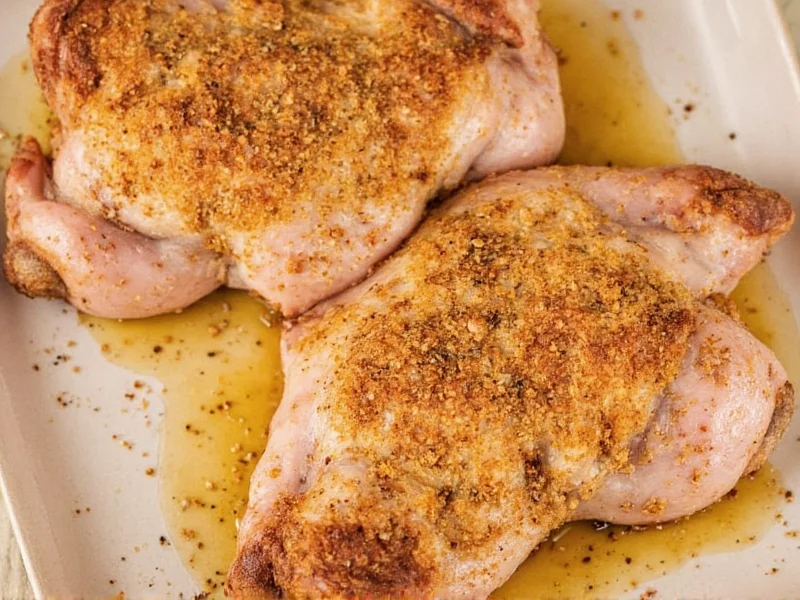Essential Components of Perfect Chicken Seasoning
Creating the ideal seasoning blend for baked chicken requires understanding the role each component plays in flavor development. The foundation of any successful chicken seasoning consists of four critical elements: salt for flavor enhancement, aromatics for depth, herbs for freshness, and fats for adhesion.
Salt isn't merely for taste—it helps break down proteins, allowing seasonings to penetrate deeper into the meat. While table salt works, kosher salt's larger crystals provide better control during application. Aromatics like garlic powder, onion powder, and paprika form the flavor backbone, delivering consistent taste without burning that fresh garlic or onions might experience during baking.
Top Recommended Seasoning Combinations
Different occasions call for different flavor profiles. Below are three versatile seasoning blends suitable for various baked chicken preparations:
| Flavor Profile | Ingredients | Best For | Application Tip |
|---|---|---|---|
| Classic Herb | 2 tsp salt, 1 tsp black pepper, 1½ tsp garlic powder, 1½ tsp onion powder, 1 tsp dried thyme, 1 tsp dried rosemary, 1 tsp paprika | Bone-in chicken pieces, whole roasted chicken | Mix with 2 tbsp olive oil, massage under skin for maximum flavor |
| Lemon Pepper | 2 tsp salt, 2 tsp coarsely ground black pepper, 2 tsp lemon zest, 1 tsp garlic powder, 1 tsp onion powder, ½ tsp red pepper flakes | Chicken breasts, cutlets, lean cuts | Add 1 tbsp lemon juice to oil mixture for brighter flavor |
| Smoky Southwest | 1½ tsp salt, 1 tsp garlic powder, 1 tsp onion powder, 1 tsp smoked paprika, ½ tsp cumin, ½ tsp chili powder, ¼ tsp cayenne (optional) | Chicken thighs, drumsticks, sheet pan meals | Pair with avocado or lime crema for serving |
Proper Seasoning Application Techniques
How you apply seasoning matters as much as the blend itself. For bone-in, skin-on chicken, gently loosen the skin and apply approximately one-third of your seasoning mixture directly to the meat beneath the skin. This technique ensures flavor reaches the meat itself, not just the surface.
For skinless chicken breasts or cutlets, create a wet rub by combining your dry seasonings with 1-2 tablespoons of olive oil or melted butter. The fat carrier helps the spices adhere during baking and prevents them from burning. Always pat chicken dry with paper towels before seasoning—moisture creates a barrier that prevents proper adhesion of spices.
Timing Considerations for Maximum Flavor
While you can season chicken immediately before baking, allowing time for the flavors to penetrate yields superior results. For best outcomes:
- Season bone-in chicken at least 30 minutes before baking
- For whole chickens, season 2-4 hours in advance and refrigerate
- Salt can be applied up to 24 hours ahead for deeper flavor penetration
- Delicate herbs like parsley or cilantro should be added after baking
When preparing chicken in advance, store it uncovered in the refrigerator. This accomplishes two benefits: it allows flavors to develop while also drying the surface slightly, which promotes better browning during baking.
Avoiding Common Seasoning Mistakes
Even experienced cooks make these frequent seasoning errors when preparing baked chicken:
Overcrowding the spice cabinet: Using too many competing flavors creates confusion on the palate. Stick to 3-5 primary seasonings plus salt and pepper for clarity of flavor.
Seasoning cold chicken: Remove chicken from the refrigerator 20-30 minutes before seasoning. Cold meat causes oil-based rubs to congeal rather than absorb properly.
Neglecting the underside: When baking chicken breasts or cutlets, flip them after 15 minutes of cooking and apply additional seasoning to the top surface for even flavor distribution.
Special Considerations for Different Cuts
Not all chicken parts require identical seasoning approaches. Bone-in, dark meat portions like thighs and drumsticks can handle bolder seasonings and longer marinating times. Their higher fat content carries flavors more effectively.
Lean cuts like chicken breasts benefit from seasoning blends that include ingredients with natural tenderizing properties, such as papaya or pineapple (in moderation). The acid in lemon zest also helps keep white meat moist during baking.
For boneless, skinless chicken breasts—prone to drying out—consider brining in a simple saltwater solution (¼ cup salt per quart of water) for 30 minutes before applying your dry rub. This technique significantly improves moisture retention during baking.
Creating Your Own Custom Blends
Once you've mastered basic seasoning combinations, experiment with creating personalized blends. Start with the foundational quartet (salt, pepper, garlic, onion), then add one complementary element at a time. Mediterranean profiles work well with oregano and lemon; Asian-inspired blends shine with ginger and five-spice powder; Southern-style chicken benefits from cayenne and thyme.
When developing your own seasoning mix for baked chicken thighs or chicken breast, keep a simple ratio in mind: 1 part potent spices (like cayenne or cloves), 2 parts medium-strength spices (like cumin or coriander), and 3 parts mild spices (like paprika or garlic powder). This proportion ensures balanced flavor without overwhelming any single note.











 浙公网安备
33010002000092号
浙公网安备
33010002000092号 浙B2-20120091-4
浙B2-20120091-4